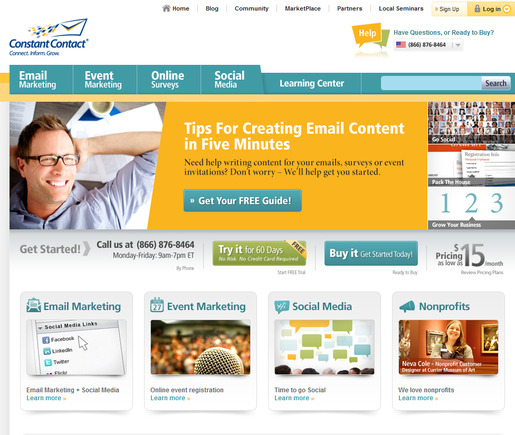Businesses have more tools to communicate with their customers than ever before. There’s email, text messaging, Twitter, Facebook, blogs and websites — and those are just the most widely used tools.
But with all those tools comes additional responsibility. Your customers should feel engaged and interested in your content and not spammed. So the challenge becomes how to best use all of these platforms without being redundant and without irritating subscribers or Fans in the process. In this article, I’ll offer suggestions for the responsible use of Facebook, Twitter and email.
Content Distribution Tools: Facebook, Twitter, Email
First, let’s outline and define the basic tools needed to spread content on the web.
- Social Media. Facebook and Twitter are useful ways to inform your audience, and direct traffic back to your blog or website. They can help spread your message across the web. Many businesses have several Twitter accounts, setting up feeds for major topics, products or ideas. Most Facebook users that are also running a business have both personal pages and business pages — it’s a powerful tool to get your message across to a wide audience.
- Email Marketing. Self-service email providers can help maintain an email subscriber list and format attractive newsletter and promotional emails, all of which will spread the word about your brand, offer deals, coupons and direct traffic back to your website.

ConstantContact is a popular self-service email provider.
Differentiate Each Platform
Each platform has different styles and is used by the audience in a different way. Businesses must be mindful of how their audiences are interacting with their brands via these various platforms. A business that annoys customers will, at best, lose a vocal advocate for its brand. At worst, it will lose a customer altogether. Here are some ideas for best practices in using the various tools outlined.
- Facebook. If you have a Facebook business page and a personal profile, don’t post redundant content onto both pages. You likely have a lot of crossover; friends on your personal page are likely also Fans of your business page. They don’t want to see duplicate posts filling up their own news feeds. You risk getting blocked by someone who would otherwise support your brand or product.Just post business-related pieces on your business page and leave the personal profile for the personal. Also, be mindful how often you ask your audience to “Like” your business page from any content delivery device you employ. You know your customers; determine how often you ask them to do this. A good rule of thumb would be to ask your audience or customers to “Like” your page once every three to six months.
- Twitter. The same rules that apply for Facebook also apply for Twitter. Either use a personal feed as a one-stop feed for business and personal thoughts, or set up multiple Twitter accounts: one that is personal and another – or several others – that focus on your business or products.For multiple Twitter feeds, create separate feeds for customer service, new product announcements, and blog updates. Your audience can decide what it wants to follow and tailor the experience for itself. Google does this effectively, at @googlestesting, @googleresearch, @googlemaps, @google.

Google Maps’ Twitter feed.
- Email marketing versus email newsletters. These two are often considered the same thing, but I think businesses would be well served by considering them as separate components of an effective campaign. Use general email marketing to offer coupons and exclusive deals to existing customers, for example. Email is also an effective way to spread the word about a service, blog post, or product that requires urgent action.You can then reserve newsletters for mostly content distribution and the general goings-on at your business. Your audience can get a feel for who you are or what your business is, personally. You are still marketing to your audience but in a more informative way.
Try to stagger both the general emails and the email newsletters so they are not appearing in an email inbox on the same day. The frequency depends on your business. If you are a content provider, a daily or weekly newsletter is a good idea, with a mass email once a month or bi-monthly. If you are a business selling goods or services, consider sending mass emails weekly and a newsletter just monthly.







